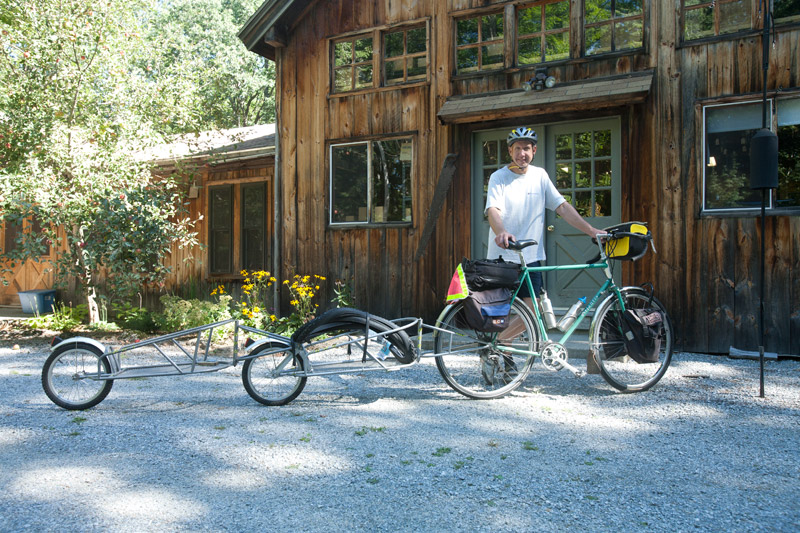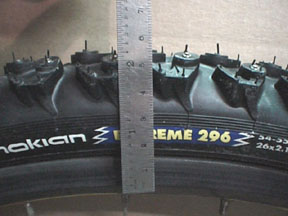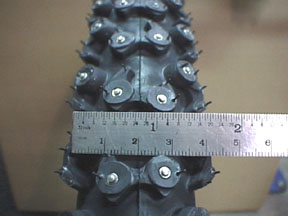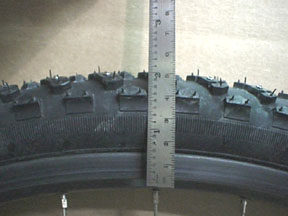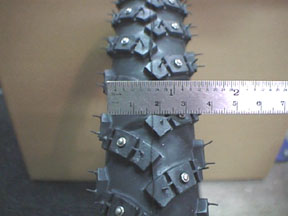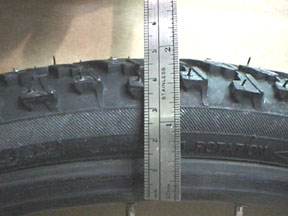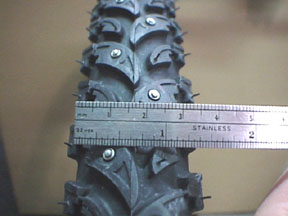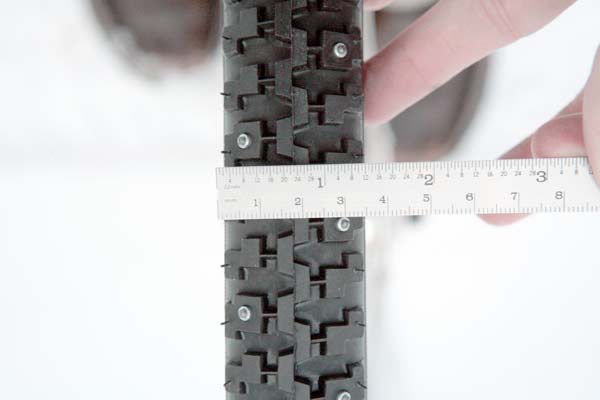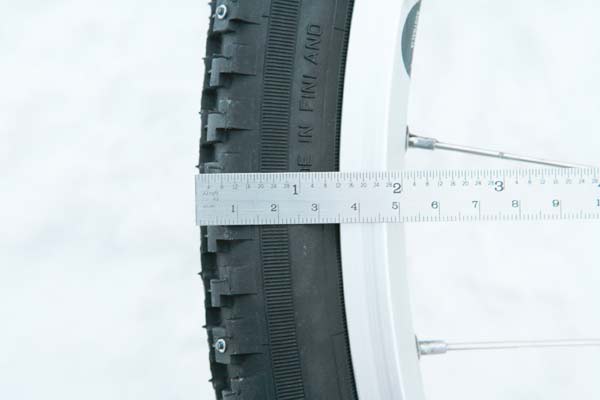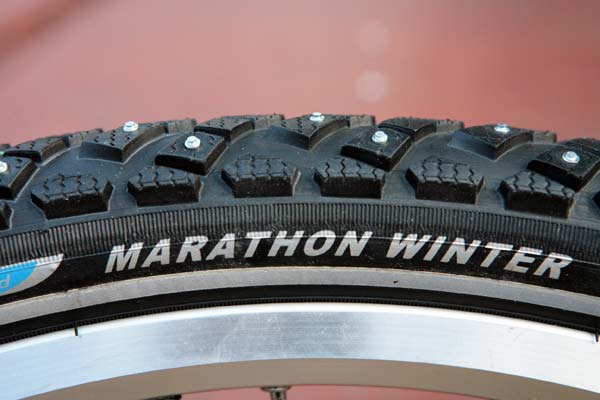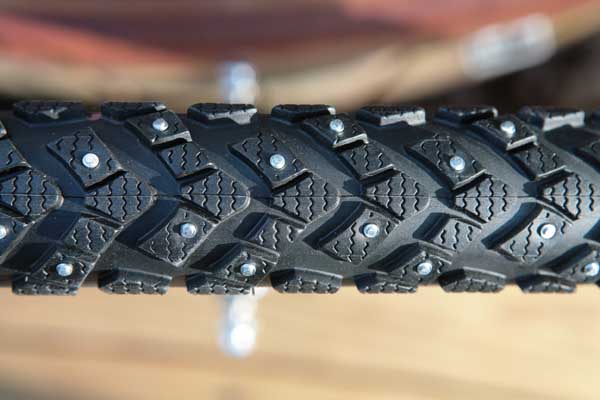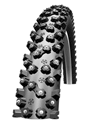Suomi (was Nokian) 45NRTH & Schwalbe Studded Tires We are no longer importing studded tires. We need the space for other products. As of December 2023, we still have some models left in stock. See below.
This web page is intended to help educate winter cyclists about studded tires. There's a lot to read on this page, and unless you are sure you know exactly what you want, it would behoove you to read the entire page before placing your order. I've put a lot of work into this page, to help you be sure that you're getting the right tire for your needs. I think you'll find that a few minutes spent reading is time well spent. You could call and ask, but many people don't know what questions to ask. This page answers many questions you may never have thought about.
Call between 10AM and 4PM eastern time M-F to place an order. In some of the photos below, the top view is a bit deceiving. Since the camera is very close to the tire and ruler, the tires appear to be a bit narrower than they are. Add 3 to 4mm to the width you see. But the relative widths are accurately shown. Also, all of the 26" tires are mounted on a relatively narrow rim. A wider rim, such as the Sun Rhyno Light, would allow the tread to flatten out 1mm to 2mm further. How effective are the studs? To describe the stud's effectiveness, I'll use an analogy. Think about walking with rubber soled shoes on three surfaces; dry clean asphalt, glare ice, and glare ice that's been sprinkled with sand. On the dry asphalt you can run and make sharp turns without any concern about your shoes skidding. On the ice, you can only walk carefully, changing direction and speed slowly, lest you Fall Down Go Boom (that's FDGB for those of you, "in the know" so to speak). On ice that someone has nicely sprinkled some sand over, you can walk easily and perhaps even run. But if you do run you won't be making any sharp turns or trying to stop quickly, as you would on dry asphalt, since you know full well that those little grains of sand aren't glued onto the ice, and can roll if pushed hard enough. Riding on ice with studded tires is like walking on ice that's been lightly covered with sand. It's pretty safe. You're not likely to fall unless you do something stupid. You're not going to have the same traction you would have on dry pavement. But you're going to have far more than you would with regular tires on ice. Keep in mind that there's ice down there and you'll be fine. Try to be a hero, and you'll probably pay a price. How do we ship? By rolling tires into thirds, we can ship tires in a much smaller box, which keeps shipping expenses lower. Nokian non foldable tires can safely be rolled up into thirds without damaging the wire bead. We have found however, that the wire beads of Schwalbe tires tend to take sharp bends easily when being rolled, so we don't roll Schwalbes. If the bead in your Nokians does arrive with a slight bend in the bead, don't worry, just gently bend it back straight with your hands. If you mount a tire that has a sharp bend in the bead, there is a chance that the tire could blow off the rim while being inflated, so any tire should be checked to be sure the wire bead is fairly straight before mounting. Tire beads can also be bent by removing a tire from a rim with tire irons, so be careful there too. I've never had a Nokian take a bend in the bead that couldn't easily be straightened. If you want us to ship your Nokian tires unrolled in a large box, just ask. We're happy to do it, but your shipping charge may be slightly higher. Those awful defective tires! Nokian and Schwalbe studded tires have a thick layer of rubber on the sidewalls. Very often you'll see small indentations in the rubber, caused by air bubbles in the rubber when it's liquid. These are not defects, the screaming epithets of bow tie clad tire collectors notwithstanding. Some folks buy tires to ride; apparently, others buy them to look at. It takes all kinds. ;-) If you want cosmetically perfect studded tires, feel free to drop by the shop and examine our entire inventory to find the best specimen for your collection. We're very accommodating. Tea and biscuits served at 11AM. Or, perhaps not. How to decide between models. As you read through the descriptions of the various models, you'll notice that I recommend some for riding on the road, some for off road, some for pavement, and others for dirt. Some work better on plowed roads, some are better for getting out of icy ruts. It can be difficult to accurately describe the differences in performance between some of these tires. Take for example the Nokian W106 700x35 and the Nokian A10 700x32. Other than the obvious difference in width and height, these two tires are quite similar in performance, though they look different. The W106 has deeper tread blocks, which makes it better in deep snow than the A10 with its finer tread. But on clear asphalt, the A10 will have lower rolling resistance, again due to the tread. But how big is the difference? Anyone who has spent much time on snow knows that it changes its consistency quite a bit between when it falls from the sky, until it finally melts away in the spring. Snow can go through many cycles of melting and refreezing. It packs down under its own weight, as well as under foot and the tires of cars and trucks. Snow at 29 degrees is very different from snow at 12 degrees. And these varying snow conditions affect the behavior of bicycle tires. You could have two identical bicycles and riders, one with the A10 and the other with the W106, and on Tuesday the W106 might work better on snow than the A10, when on Wednesday, the A10 could be better. Nothing has changed other than the snow, which has been on the ground another day, or perhaps has had another layer added overnight. There's really no way of predicting how two tires might compare all the time. And, the difference in rolling resistance, while real, isn't like the difference between riding a full knobby mountain bike tire and a high quality slick tubular sewup racing tire with silk casing. It's a fairly small difference. All studded winter tires are going to have high rolling resistance, compared with fast summer tires. A half hour summer commute can easily become a 35 minute commute on studded tires. And if I had to guess, I'd say the difference in riding time for that half hour commute, comparing the W106 and the A10 on clear pavement, would generally be more like a minute. So, yeah, it's real, but how important is that minute to you? Perhaps the added clearance between the tire and fender offered by the smaller A10 would be more important. Or maybe the greater distance between the road surface and the rim, due to the larger tire size in the W106 would be most important. If you're dealing with water covered potholes in Boston, it may well be. Only you know the answer to that. Picking up?
We can ship tires just about anywhere. But wouldn't it be more fun to ride over and pick them up? Keith Stebbings used his Atlantis and a tandem pair of heavily customized BOB trailers to pick up his new set of Nokians. We don't need no steenking cars! Air Pressure Ignore the printed pressure ratings on the sidewalls of studded tires, and all bicycle tires for that matter. The tire manufacturers know that most people hold the erroneous belief that the higher the pressure, the better. So they base their pressure rating on some percentage of the highest pressure the tire will hold before blowing off the rim. But that doesn't mean that your rim will withstand the force placed on the sidewall by your tire at that pressure, or that the ride at that pressure will be better. I'll soon have a more complete explanation posted here. But for now, use the following as a rough guide to air pressure. The skinniest tire we sell is the Nokian A10 700x32 or 30-622. 30 to 32mm wide. Use 60psi as the maximum pressure in this tire. The widest tire we sell is the Schwalbe Ice Spiker Pro 700x2.25 or 57-622. 57mm wide. Use 30psi as the maximum for this tire. (I run mine at 25psi) As the tire gets fatter, the PSI must be lower. If the 57mm wide tire could hold 60psi, the rim's sidewalls would be subject to extremely high loads, and would soon crack, unless you were using an extremely heavy rim, which most people wouldn't want to use. 700c 45NRTH Xerxes 700x30, 45 studs The Xerxes is a high quality studded tire for winter commuting. 700c 45NRTH Xerxes 700x30, Part # 45TR4576, Price: $ 60.00 each. In stock. 700c (29er) Suomi/Nokian
The Extreme is now only available in the 27.5 or 650b size, 57mm wide. The photos above are of the older 26" version, which had 296 studs. This tire is for aggressive riding off road in any conditions. This is a very tough tire, suitable for all riders in all off-road conditions. The aggressive tread pattern will be slow going on clear paved roads due to high rolling resistance compared to a smooth tread summer road tire, just like any knobby mountain bike tire. If you want to ride the same single track trails you ride in summer, when the snow's a foot deep and ice is everywhere, rutted from cross country skiers and snow shoes, the Extreme is the ideal tire. By the way, with no snow or ice on the ground, don't ride aggressively with studded tires. Just as riding hard will wear the tread blocks of regular knobby tires quickly in summer, it will do the same in winter, and the studs will be more likely to rip out of the tire. Take it easy on the clear patches. 650b WXC'R 312 SWA 27.5x2.25 57-584, Part # NOKT417981, Price: $ 130.00 each. In stock. 26" by 2.2" Nokian Hakka WXC 300
For you gram counters, there's a tire similar to the Extreme but with an aramid fiber bead, rather than a standard steel bead. That saves weight, and makes the tire foldable. Like the Extreme, this tire is only suitable for off road cycling; the kind of riding you do on a real mountain bike with fat knobby tires in the summer and fall. If you use these tires on paved roads, you're wasting your money and working harder than you would otherwise have to. The large tread knobs cause high rolling resistance on smooth pavement. But if you want to ride fast on narrow winding singletrack, this is our best tire. We have studded tires for riding on roads. See below. As with all Nokian studded tires, the studs are made of extremely hard carbide, not steel, so they last a long time. 695 grams. 57-559 - 26x2.2" Cost: $ 140.00 each. In Stock By the way, with no snow or ice on the ground, don't ride aggressively with studded tires. Just as riding hard will wear the tread blocks of regular knobby tires quickly in summer, it will do the same in winter, and the studs will be more likely to rip out of the tire. Take it easy on the clear patches. 559 - 26" Nokian Mount & Ground W160 A great all purpose tire.
This is the Nokian Mount & Ground. 160 carbide studs. A bit
smaller than the Extreme, and the tread blocks are shallower, so they
squirm less on pavement, reducing rolling resistance.
This is a good tire if you'll be riding on road as well as off,
and if you're taking things a little easier off road. Not as good for aggressive singletrack riding as the Extreme 294, below. Rolling resistance
will be a bit lower than with the Extremes when on pavement. With the studs placed further to the sides of the tread than
with the Hakkapeliitta W106, the M&G is much better for getting you
out of an icy rut. So if you ride on dirt roads that don't get plowed
well, this is a good choice. If you have
a mountain bike with 26" tires, these will fit. Photographed
inflated on a Mavic 517CD Ceramic rim. Mount & Ground, Cost: $ 60.00 each. In Stock. A 200 lb rider would inflate these to about 45psi. A 140 lb rider would inflate to about 35psi. These are my estimates. The best way to determine optimum pressure is trial and error. By the way, with no snow or ice on the ground, don't ride aggressively with studded tires. Just as riding hard will wear the tread blocks of regular knobby tires quickly in summer, it will do the same in winter, and the studs will be more likely to rip out of the tire. Take it easy on the clear patches. Some fool has started a rumor on the internet that the Mount & Ground is no good on pavement since the studs are too far to the outside and they don't touch the ice. That's simply not true. The Mount & Ground works fine on plowed roads. The studs are in constant contact with the pavement. Anyone who believes otherwise has never used them.
559 - 26" Nokian Hakkapeliitta W106
This is the Nokian Hakkapeliitta W106 26 x 1.75-1.9. 106 carbide studs. This is a nice tire for road riding when you don't want to be caught unawares by black ice. Very good in snow too. Rolling resistance will be greater than with a smooth tread summer tire, but less than with the Nokian Extreme 296 or the Mount & Ground 160. Don't be put off by the lower number of studs. Even though the Hakkapeliitta W106 has only 106 studs, they are positioned just where you need them for riding on a road that gets plowed. Plowed roads don't develop deep icy ruts, so you don't need studs towards the sides of the tire to get you out of a rut. The Hakkapeliitta has all of the studs in towards the center of the tire, unlike the Mount & Ground which places the studs more towards the side. So it's just what you need for snow and/or black ice on good roads. If you have a mountain bike with 26" tires, these will fit. Not a good choice for unplowed roads or walking or snowmobile trails. Photographed inflated on a Mavic 517CD Ceramic rim. 850 grams. Not a foldable tire.26" W106 26", 47-559 Cost: $ 65.00 each. In Stock I have these tires mounted on my Tout Terrain touring bike. By the way, with no snow or ice on the ground, don't ride aggressively with studded tires. Just as riding hard will wear the tread blocks quickly in summer, it will do the same in winter, and the studs will be more likely to rip out of the tire. Take it easy on the clear patches. 622 - 700c Nokian A10, AKA "Stud" For commuting in urban areas that are likely to be well plowed, but also likely to have icy patches in the evening after a sunny day, the A10 has the lowest rolling resistance of any studded tire. It may not be as good in the snow as the W106, but let's face it, lots of riders hardly ever ride through much snow. In winter, commuters mostly have to deal with ice. The 40mm A10 measures 36mm wide and 36mm high on the Dyad rim. 40mm, 74 carbide studs, 910 grams: $ 60.00 In Stock I expect to have photos of the 700c versions up soon. For now, see the photos of the 650b tire below. The main difference is that the 700c tires have fewer studs, so the studs are placed further apart circumferentially. But side to side, the stud placement is identical, and the tread is the same. By the way, with no snow or ice on the ground, don't ride aggressively with studded tires. Just as riding hard will wear the tread blocks quickly in summer, it will do the same in winter, and the studs will be more likely to rip out of the tire. Take it easy on the clear patches.
The lens is just a few inches from the scale. Because of this, the image is distorted a bit, and the tire appears to be narrower than it actually is. This is the 40mm A10, With my caliper it measures exactly 35mm wide on a Velocity Synergy rim.
This is the 40mm wide A10. It measures 35mm, width and height. Great for ice, OK for snow, it's ideal for the urban commuter, or anyone riding on roads that are well plowed. By the way, with no snow or ice on the ground, don't ride aggressively with studded tires. Just as riding hard will wear the tread blocks quickly in summer, it will do the same in winter, and the studs will be more likely to rip out of the tire. Take it easy on the clear patches. Schwalbe Marathon Winter & Marathon Winter Plus
A fine all around tire for snow and ice. The perfect tire if you want one tire to do everything. Rolling resistance is a bit lower than with the Nokian Hakkapeliitta W106 if you're riding on clear smooth pavement. 2mm tread block height. The Nokian W106 (3mm tread block height) or IceSpeed (4mm tread block height) might be a bit better in deep snow, but even that statement needs qualifying as it would depend on the condition of the snow; age and current tempurature. But with 200 studs in the 26" model, and with studs further to the side of the tread, this tire will get you out of icy ruts almost as well as a pure singletrack tire like the Schwalbe Ice Spiker or Nokian Extreme. These are similar to the Nokian Mount & Ground, which is only available for 26" (559) rims, but with lower rolling resistance on clear pavement, and a bit less grip on snow because the tread blocks are shallower. I have these in three other sizes; 20x1.6 (ISO 406) for folding bikes, BMX bikes, and recumbents, 700x35 and 700x42 for road touring bikes or the so-called 29er bikes. These are not foldable tires. All sizes have Kevlar belts for puncture protection, a reflective sidewall strip and a dynamo strip. For the 2018-2019 season, Schwalbe has replaced the Marathon Winter with the Marathon Winter Plus. We still have stock of the older version in most sizes. The difference is the 'Plus' tires have an extra layer of rubber (5mm thick) for puncture resistance between the tread and the casing. This adds some about 10 grams of weight and some rolling resistance. Marathon Winter Plus 20" version: ETRTO, 42-406, Part # SWL11116448.02, Price: $ 70.00 In Stock. Marathon Winter Plus 24" version: ETRTO, 47-507, 24x1.75, Part # SWL11125444.01, Price: $ 70.00In Stock. Marathon Winter 700c (29er) version: ETRTO 50-622, 240 studs, 30 psi to 45 psi, Part # SWL11100597 Price: $ 70.00 In Stock. Marathon Winter Plus 700c (29er) version: ETRTO 50-622, 240 studs, 30 psi to 45 psi, Part # SWL11100597.01 Price: $ 75.00 In Stock.
The Marathon Winter is a much improved version of the "Snow Stud" we had a few years ago. It has more studs and a higher quality casing. The slightly shallower tread blocks make for less rolling resistance for the urban commuter, who will see mostly ice.
As you can see, the Winter has studs in the center of the tread as well as to the sides of the tread. This gives you maximum traction on flat ice as well as in rutted ice. There's nothing worse than having your tire literally stuck in a rut with no way to climb out. But with studs at the sides of the tread, the Winter can easily climb out of ruts. By the way, with no snow or ice on the ground, don't ride aggressively with studded tires. Just as riding hard will wear the tread blocks quickly in summer, it will do the same in winter, and the studs will be more likely to rip out of the tire. Take it easy on the clear patches. Schwalbe Winter The Schwalbe Winter has essentially the same tread as the Marathon Winter, but eliminates the studs off to the side of the tread. If you're always riding on plowed roads, and so never have to deal with icy ruts, you don't need the studs at the side of the tread, and you can save money. I stock these in the 700x30 and 700x40 sizes. Schwalbe Winter, 700x30, Part # SWL11100600, Price: $53.00 In Stock Schwalbe Winter, 700x40, Part # SWL11100602.01, Price: $53.00 In Stock 559 - 26", 700c-29er & 27.5 x 2.60 Schwalbe Ice Spiker / Ice Spiker Pro Click the image for a larger illustration. The Ice Spiker is an aggressive off road tire for single track riding in snow and ice. You'll get excellent traction in most conditions. If these won't work, nothing else will either, so get out your cross country skis! The studs are placed in the center as well as the sides of the tread for great grip climbing, braking and cornering. Kevlar belted for puncture protection. Rolling resistance will be quite high if you need to use these on clear smooth pavement, so unless your commute follows the Appalachian Trail from Crawford Notch to Pinkham Notch, you might want to think about a different tire. But if you want to have fun in the woods on your bike, this is your tire. The Ice Spiker is not a foldable tire. The Ice Spiker Pro is a foldable tire. Ice Spiker, 26x2.1, Part # SWL11132801, Ice Spiker Pro, 26x2.1 (foldable version of Ice Spiker), Part # SWL11632609, Ice Spiker Pro 27.5x2.6 (Big Juicy Ice Spiker Pro for 27.5 {650b} bikes), By the way, with no snow or ice on the ground, don't ride aggressively with studded tires. Just as riding hard will wear the tread blocks quickly in summer, it will do the same in winter, and the studs will be more likely to rip out of the tire. Take it easy on the clear patches. You can let 'er rip on the ice, but not on pavement or rocky trails. Stud wear and stud damage are two different things. The studs don't wear out, being carbide. But they can be ripped out. How to fit the fat ones. Look at your existing tires. Let's say they have 700x35 printed on the sidewall. The W106 700x45 will be 10mm taller and 5mm wider on each side of the tire, 10mm wider in all. You need to look at three places on your bike to see if these 700x45 tires will fit. With your current 700x35 tires mounted, look at the fork, right at the top where the tire comes close to the fork blades. If you have only 10mm of clearance over the top of the tire, between the tire and the fork, the larger 700x45 tire will be touching the frame, and you won't be able to ride your bike at all. If your existing 700x35 tire gives you 20mm of clearance, the 700x45 W106 should leave you with 10mm of clearance, which I think would be enough to be safe. In my opinion, any less that 10mm over the top of the tire is not enough to be safe. And keep in mind that even with more clearance, it's always possible for something to get thrown up between the tire and the fork crown and jam the front wheel, causing a crash. There is no absolute safe amount of clearance! But if my bike had 10mm over the top, I'd be happy with that. Now look at the sides of the tire and the fork blades. If there's only 5mm of clearance on each side, the wider 700x45 won't fit. Ideally you should have 10mm on each side of the tire, between the tire's sidewall and the fork blades, not so much because something may get caught there (though something could) but because if (for example) your bike fell over and the front wheel became slightly out of true, the warped wheel could cause the tire to rub on the frame with every revolution of the wheel, and you'd have difficulty getting home where you could fix it. 10mm on each side just gives you enough clearance that you would be very unlikely to have trouble with a slightly warped wheel. Now look at the rear tire. There are two places on most bikes where the rear tire comes close to the frame; between the seat stays and the chain stays. The seat stays are the two tubes that go from the rear hub upwards towards the saddle. The chain stays are the two tubes that go from the rear hub forwards towards the crankset, that's what your pedals are attached to. You need to have the same 10mm of clearance above the tire and on each side of the tire at those two locations in the rear as you do with the front tire at the fork. If your rear tire were to rub on the frame it would not be nearly as dangerous as having the front tire rub on the fork, but it would be a serious nuisance. And if the tire were to rub for more than a few minutes, it could result in a flat tire which can ruin your whole morning if it means you're late for work. So look carefully at the rear tire at both the seat stay bridge (the little tube connecting the two seat stays right above the tire) and at the chainstays, which may or may not have a bridge. And make sure there's 10mm above the tire and 10mm on each side of the tire when you have the new fat tire installed. That means your existing 700x35 tire needs 20mm clearance above and 15mm clearance on each side for optimal clearance with the new fatter tires. You're welcome to use tires that leave you with less clearance. For example, since I'm a wheel builder and I always ride with a spoke wrench, I'm happy to ride with less than 10mm clearance on each side of my tires, since if I did get a slight warp in a wheel, it would only take me a minute or two to correct it while standing on the side of the road. You might also decide that the risk of having a tire rub is worth it to get the larger tire. And if your rear tire jams something between it and the frame while you're riding and locks up, you'll likely skid to a stop without falling, unlike the almost certain hard crash that will occur if your front wheel jams and can't rotate while you're riding. That's extremely dangerous! So you could ride safely with less clearance in the rear than you can in the front. Don't take risks in the front! Studded Tire Failure Mode! Studded tires wear out differently than other tires. The studs have flat heads on them, much like roofing nails. The heads are embedded inside the tire tread so you can't see them. But they move a bit with every rotation of the wheel, wiggling back and forth. This movement will eventually damage the fabric tire casing. You can see the damage only when you remove the tire from the rim and look at the tire casing from the inside. This damage takes quite a while to happen. I've not seen a tire damaged by the studs that was used less than 6 years or so. What you'll see when the tire is damaged is crescent shaped cuts in the casing all around the tire. The cuts are being made by the heads of the studs. If you use one set of wheels year round, and just change from summer tires to studded tires in the late fall, you'll have the opportunity to see the tire casing twice a year. But some people have two sets of wheels; one for summer and the other for winter, so they can go many years without ever seeing the inside surface of the studded tire's casing. This is dangerous, as a casing failure could lead to a blow out. So I recommend that if you leave your tires mounted on rims all year round, every three years or so you remove them and carefully inspect the inside casing of the tires. If you just see some crescent shaped light grey marks in the black casing, don't worry, but start checking them every single year for cuts in the casing. Grey marks are fine, cuts are bad. Once you see cuts in the casing, stop using the tire. It's time for a new one. One Tire Only in Front? People often ask me if one studded tire in front is sufficient. Well, one studded tire in front will help keep you from crashing hard and breaking your collar bone or your pelvis. When the front tire slides, you go down quite fast and without warning. If the rear tire slides you can still go down, but not as fast, and the results are usually not so calamitous, since you usually have enough time to get a foot out of the pedal. But with just a front studded tire, you can still crash. You can still not be able to climb a hill with black ice. You can still not be able to get out of an icy rut. You can still spin on a downhill curve. You can still lose control in a busy intersection with lots of traffic. And you can still spin during hard braking. So, for the life of me, I can't see any reason to use a single studded tire in front, except to save a few dollars. I do occasionally sell a single tire to someone who's been told by a friend that you only need a front studded tire. Similarly, there are many folks who think you can get away with snow tires just on the drive wheels of an automobile, which leads to cars spinning out of control because the front or rear has so much more traction than the other. Invariably I get a call a week later from the same customer ordering a second tire. He ends up with no cost savings, since he has to pay twice for shipping. If you are buying tires for riding single track in winter, and you need to save money, there is a way to do it. Get a very aggressive tire for the front, an Extreme 294 or Ice Spiker, and then use an Extreme 120, Mount & Ground or Snow Stud in the rear. You won't get quite as good grip while climbing a steep trail as you would by having aggressive tires front and rear, but if your trails aren't too steep, you should be just fine. The more aggressive front tire will still be there to get you through icy ruts. For the commuter riding paved roads, there really is no alternative to having the W106 or A10 on both wheels. So unless you're riding to work on rail trails, I strongly recommend you use studded tires on both wheels, not just the front. What Else? It's not enough to keep from crashing on the ice while riding in winter. To keep your wheels and studded tires from being stolen, you'll want Pitlock skewers. If you want to see where you're going at night, you'll want a Schmidt dynohub and suitable lights. Other Studded Tires I frequently get requests for other brands of studded tires. The only brands of studded tires I know of that I think are a good value are the Nokians and the Schwalbes. Other brands don't have carbide studs, so they wear quickly. About the studs The studs in all Nokian and Schwalbe tires are made of carbide, which is a very hard material. The studs are quite durable. But it is possible occasionally for a stud to come out of the tire. This is most likely to happen when riding single track on the Extreme 294, the Hakka WXC 300, the 700c Hakkapeliitta W240, or the Schwalbe Ice Spiker. On single track in winter you can get a mix of snow, ice and exposed rock. When climbing steeply or braking hard while descending, studs can occasionally tear out of the tire when you go over exposed rock. It happens rarely, and mostly it happens with heavier riders, say over 200 lbs. Losing a stud once in a while is no cause for alarm, it's normal wear and tear, and is not covered by the warrantee. With 294 studs in the Extremes for example, you'd have to lose a whole lot of them for the tires to perform poorly. And in fact, most riders will never lose a stud on the Nokians I sell. But it can happen. Just keep riding, have fun, and don't worry about it. And don't worry about the studs damaging your inner tubes. They won't. The tires are carefully designed to prevent the studs from puncturing the tube. The base of the stud is flat, like the head of a nail. So (to extend the analogy) the point of the nail is outside the tire to grip the ice, and the head of the nail is embedded in the tire casing. And, yes, you do need inner tubes with our studded tires. They will not work without inner tubes. And, you can just use your regular old inner tubes. You don't need special tubes for these tires. As tires age, the casing deteriorates, and then the studs can push through the casing. But it's not so much that the studs are damaging the casing, but more that the old worn out casing can't keep the studs in place. The studs will not make the bike skid on pavement. If they did we couldn't sell them. They only help the tires to NOT skid on ice. They have no effect on pavement, except for a chattering sound. Like all things, studded tires will eventually wear out. The casing may fail around a knob. Some knobs may break off. Some studs will rip out. The sidewalls will tear or shred. This happens to all tires eventually, these Nokians and Schwalbes are no different from other high quality tires. We could sell tires that would outlast your bike. But they would be too heavy and you wouldn't want to ride. So I suppose that would make them last even longer. When your tires wear out, you'll have lots of great memories of all those rides that wore out your tires. So when they wear out, don't get mad. Get another pair and go back out and ride some more. One thing's for sure. Your winter tires with carbide studs will outlast any other studded tires available, at least those that use steel studs. Getting off your bike! So there you are, riding along on glare ice with good control. You start to think you're a hero. And then you have to stop. So, you grab the brakes, the bike comes to a controlled stop, and you put your foot down, just like in the summer. ZING! Your foot slides to the side, and you fall over doing a perfect Olga Korbut split. That's right, your shoe doesn't have carbide studs like your tires. So, unless you're a gymnast, be careful when you stop on ice! 27" & various other sizes? There are no 27" tires available with carbide studs. Don't confuse 700c with 27", or with 27.5", they aren't the same. Please don't call or write asking for 27" studded tires. They don't exist and since there are virtually no bicycles in current production using 27" tires, I would be shocked if any company would start making a 27" studded tire. Also, there are no 16" or 12" or 18" studded tires. To my knowledge, no studded tires exist for penny farthings, Tonka Trucks, Formula 1 race cars or baby carriages, although I saw a report on Fox News that babies have entered a class action suit in federal court against tire manufacturers claiming discrimination. So, stay tuned. I Have a Racing Bike! I'm sorry you have a racing bike. Really, I am. The reason I'm sorry is that nobody makes a studded tire that will fit on any modern road racing bicycle. Racing bikes typically come with 700x23mm (23-622) tires. If you look at the clearance between your tires and those parts of your bike that the tires come close to, you'll see that there is probably no more than 4mm or 5mm clearance at some points. And at the top of the tire, particularly where the tire goes under the front brake, you could have as little as 3mm of clearance. Since the smallest 700c (622) studded tire is 32mm, measuring about 30mm tall and wide, there is simply no way that they will fit in most racing frames. Frequently Asked Questions Q: Do the studs really work? A: No. It's hard enough just getting the lazy bums out of bed in the morning. Forget about work! Q: How long will the tires last? A: About two weeks, or two miles, which ever comes first, or last, or... Q: I normally ride 700x35 tires. Will the 700x35 tires fit on my bike? A: Absolutely not! But they'll make great wall hangings for your garage. Q: Are you just kidding? A: Moi? The Real FAQ! Q: You used to say that only Nokian made good studded tires. Why have you changed your tune and are selling Schwalbe? A: Schwalbe used to specify steel studs for their studded tires. Now they have carbide studs, just like Nokian, so I'm now happy to sell Schwalbe studded tires as well as Nokian. We've been selling many other Schwalbe tires for several years now (see my web page) and the quality is terrific. We've been very happy with the quality of the Schwalbe studded tires. Q: Will the studs rust? A: Yes, you'll get some surface rust on the studs, it's normal, and it has no ill effect on the studs. Just keep riding! ;-) Q: Are replacement studs available? A: No, unfortunately. I have loose studs here for installing in new tires that arrive here with a stud missing. But I have no studs to sell for replacement. Q: How can studs fall out of the tire tread? A: The main reason studs fall out is riding too aggressively on pavement or on rocky trails. You cannot use studded tires on dry ground the same way you would use summer tires. On ice, you can ride as hard as you dare without damaging the tire or losing studs. But when you reach a bare patch of ground, you must take it easy, lest the studs be ripped from the tread. Q: Why do Nokian tires have a tag stating that you should ride the tires on paved roads for 30 miles before using them on ice? A: It's because Nokian is very sloppy in how they install the studs, and doesn't take the time to ensure that every stud is fully seated in the tire tread before shipping it. With some studs partly hanging out of the tire tread, if you ride them hard, the studs can easily fall out. Riding them "easy" is supposed to help seat the studs. Of course this as all just bovine excrement, and those half seated studs can still easily fall out. But don't worry. Before we ship any studded tire, Nokian or Schwalbe, my staff carefully check every stud on every tire to be sure they are all correctly and fully seated in the tire tread. Any tire with studs that are not fully seated, or missing, are given to me and I, Peter Jon White, then seat or replace any missing studs personally. We'll ship no tire with missing or partially seated studs. That means you don't have to fool around riding slowly. Ignore the silly and misleading message from Nokian when you buy tires from me. Q: I've heard about Nokian tires losing up to half their studs. Is that possible? A: Yup. Several years ago, (maybe 2001?) when Nokian first made a foldable studded tire, the Hakka 300, there was at least one flaw in the design and/or manufacturing process which caused the tread blocks to tear apart and the studs to fall out. The problem persisted for two years before finally being corrected. I don't know why it took so long to fix. They first made several changes to the tires which didn't completely fix the problem. But finally they got it right and the Hakka 300 is now a great tire which I am happy to recommend and sell. Q: My friend heard that studded tires will skid on roads without ice because the metal studs can slide on the pavement. Isn't that true and shouldn't I only use them on ice? A: While it is obviously true that a tire made entirely of carbide would have precious little traction on asphalt, the carbide studs in bicycle tires, as well as those in automobile tires only protrude a very short distance from the rubber surface; one millimeter in the case of bicycle tires, and about 3mm in the case of automobile tires. The studs are embedded in relatively soft rubber, so when the stud contacts pavement, it sinks back down into the tread, and only slightly effects the contact pressure of the surrounding rubber for perhaps 1mm in radius, leaving well over 99% of the remaining tread with exactly the same contact with the pavement, but with infinitesimally higher pressure. On the softer ice, the carbide stud sinks, not back into the tire tread, but into the ice. Anyone claiming that studded tires have less traction on either wet or dry pavement only proves that he's never ridden a bike with studded tires, nor driven a car with them. They are perfectly safe on roads without ice. Were that not the case, tire manufacturers would have been hauled into court decades ago and studded tires would have been banned. While in the cycling world there is some confusion about the subject, in the automobile world studded tires are well known as the life saving devices they are. Since every driver knows that in a typical winter, you spend perhaps 2% of your time driving on ice, and the rest of the time on clear pavement, were there any truth to the notion of these tires being a danger, they wouldn't be available for sale, certainly not in our litigious society. There is nothing to be concerned about. Q: Most days in winter there's no ice on the roads. Should I swap out the studded tires for regular tires when I know there won't be ice? Won't my studs last longer if I don't ride them on clear pavement? A: No. You should put the studded tires on in the late fall and leave them on all winter. If the studs were made of steel, you would need to be concerned about wear. But the tires I sell do not have steel studs. Our carbide studs last as long as the rubber tire itself, so there's no need to worry about stud wear. And, you never know when water might find its way onto the road surface during the day, only to freeze after the sun goes down and you have to ride home from work. It's best to be safe. Leave your studded tires on all winter. Sure, they're a little heavier, and you can hear the studs chattering on the pavement. That's the price of added safety. The Most Frequently asked Question of All! Q: Which tire should I buy? A: I'll try to boil it down here. Singletrack If you don't know what singletrack means, feel free to skip to the next section, and don't buy the Nokian Extreme 294, 700c Extreme 294, Schwalbe Ice Spiker or Ice Spiker Pro. If you ride singletrack, you know that your tires need to have large knobs or tread blocks to give you traction climbing, descending and cornering on dirt, leaves and gravel. In the winter, you need the same type of tires you use in summer, but to deal with ice, you also need studs. The various Nokian Extremes and Schwalbe Ice Spikers have aggressive knobby treads, just like summer tires, but on many of the tread knobs, they also have a carbide stud. So these tires are for riding singletrack in winter. Just like in the summer, if you ride knobby tires on a paved road, your bike will roll slower than it would if you had a smooth tread tire. We have studded tires for riding on the road. So you don't need to use knobbies with studs on paved roads. Use knobbies on singletrack. Dirt Roads and Paths that May or May Not be Plowed Roads and bike paths that only sometimes get plowed are likely to have icy ruts. What's an icy rut, mommy? It's when snow falls, and a car or bicycle is driven over the snow, and then it rains or gets warm, and the snow starts to melt, and then the temperature drops, and the tracks made by the car or bicycle tires becomes a semi permanent fixture on the surface of the ice. If you ride your bike into one of these ruts, it's difficult for the tire to leave the rut. It might start to climb up the side but then it slips down to the bottom of the rut. In order to get out, the tire must have studs positioned towards the side of the tread, so it can grip the side of the rut, and climb out. Tires such as the Nokian W240, Nokian Mount & Ground (M&G), and Schwalbe Marathon Winter all have studs placed towards the sides of the tread. The M&G has the least studs, and is least expensive as a result. The W240 has 240 studs and a moderately aggressive tread, almost as aggressive as a singletrack tire but not quite, and it therefore has lower rolling resistance when you are on clear pavement than a knobby would have. If you ride mainly on plowed roads, but want to be safer in the event you do decide to go off on some unplowed trails, one of these tires is your best choice. Rolling resistance might be slightly higher than with a pure road tire like the Nokian A10, but if you do get into a rut, you'll prefer having one of these rather than the A10, or a W106. Plowed Roads If you only ride on roads that are regularly plowed, you'll never have to deal with icy ruts. If you never have to ride on rutted ice, you won't ever need studs towards the sides of your tires. You only need studs in contact with the ice when your bike is upright or just leaning in a turn. Turning doesn't require studs near the sidewall of the tire. So a tire like the Nokian W106 or Nokian A10 will be just fine. These tires are less expensive because they have fewer studs, and studs are expensive to make. While I haven't done a side by side comparison, my educated guess is that the W106 should give better traction when riding on new snow, or while it's snowing. But I suspect the A10 has lower rolling resistance when riding on clear pavement. Remember! Studs only affect traction on ice. Studs have no affect on snow or dirt or pavement, either wet or dry. So when you look at the photos of the various tires, you're looking at two things: the rubber tread, and the location of the studs. They are two entirely separate issues, because the rubber tread has no influence whatsoever on ice, and the studs have no influence whatsoever on anything other than ice. So when I talk about one tire being better in snow than another, it has nothing to do with the studs, only the rubber tread. For a host of information about cycling in winter, try the Icebike website. Back to: Peter White Cycles LLC home page Penny is the Lord High Executioner of Email. So please send your email to Penny. Mail to: The email link above uses some fancy javascript voodoo to hide the actual address from spambots. Your browser needs to be set to run javascript in order for you to use any of the email links on my website. If you can't see the links, you can call us. You can also type the address into your email software. First, type the alias, "penny". Then type the "@" sign. It's above the number 2 on your keyboard. Then type the domain, "peterwhitecycles.com". Don't put in the quotes! That should do it. You can also call us at 603 478 0900 It's best to call before 4PM Eastern time since after that we're either running around like headless chickens or at home ready to jump into the pot. Please don't place an order without first reading this. This page updated: Wednesday, January 15, 2020 Peter White Cycles LLC (C) Copyright Peter Jon White, 2002. |
